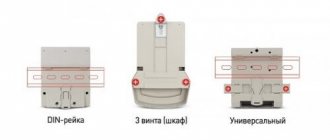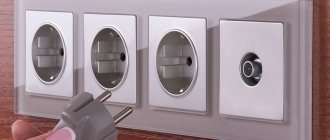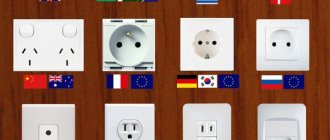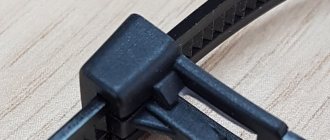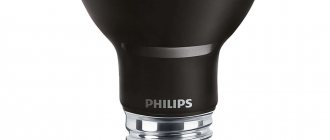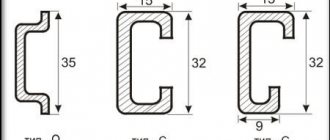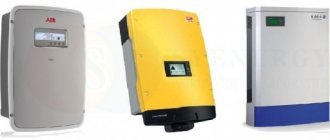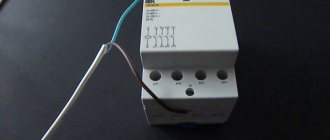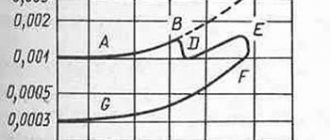The modern electrical goods market offers a large number of types of sockets and switches of various purposes, designs and quality. For the correct and safe operation of such electrical equipment, you need to be able to choose a model for each specific case. Not the last place in the choice is occupied by the manufacturer of electrical goods and the materials used in the production of sockets and switches.
- 2 Types of switches
- 3 How to choose an outlet for your apartment
- 4 What to look for when buying a switch
- 5 Features of choosing sockets and switches for the bathroom
- 6 How to distinguish high-quality devices from low-quality ones
Types of socket connectors
Depending on the country in which certain standards are legislated, sockets differ in the number of contact elements, as well as their shapes and sizes. Moreover, each device has a letter designation approved at the end of the last century by the US Department of Commerce. The classification proposed by the Americans was approved by other countries, and is currently valid throughout the world:
Type A
A is a standard that was once widespread throughout North America. Following the USA, it began to be used in 38 countries. This type consists of two ungrounded flat contacts arranged in parallel. A grounding element is not provided in this case. Today, such devices can still be seen in many older buildings, since they are all compatible with the modern type of plugs. The Japanese standard has certain differences, providing additional requirements for the parameters of product housings.
Type B
B - an improved version of the American standard, supplemented at the bottom of the structure with a long round contact that provides grounding. In addition to the United States, these types of electrical outlets are used in Canada and Mexico. They are also found in several South American countries, including Colombia, Ecuador and Venezuela.
Type C
C is the most common standard in Europe. The so-called Euro socket, consisting of two round contacts, is used, among other things, in the CIS, as well as in the Middle East and most countries of the African continent. There is no grounding in this design. In the Russian Federation, the dimensions and safety requirements for such products are determined by GOST 7396.
Type D
D is an outdated standard previously used by the British in territories that belonged to the British Empire. At the moment, sockets with three round contacts located at the vertices of a triangle are mainly used in India, and are also found in old houses in other countries, where the British once had a hand in arranging power supply lines.
Type E
E is a modern French standard, differing from type C by the presence of a grounding contact, which is located at the top of the device. Similar electrical network elements are also used in Belgium and Poland. At one time they were introduced into the territory of the former Czechoslovakia.
Type F
F - European standard in the form of a design of two round contacts, complemented by grounding brackets at the top and bottom. Initially, such devices appeared in Germany and began to be used for alternating current. These types of sockets and plugs are also called "Schuko", which is an abbreviation for the German Schutzkontakt, literally translated meaning "safety contact". The products are fully compatible with Russian and Soviet-made plugs.
Type G
G is a British standard that requires a fuse located inside the plug. The device consists of three flat contacts, two of which are located at the bottom and one at the top. It is possible to connect Euro plugs using a special adapter, which must also have a built-in fuse. This type of electrical network elements is supported in Ireland, as well as in the territories of some states that were once British colonies.
Type H
H is the Israeli standard, which consists of three round contacts (until 1989, flat elements were used), forming the Latin letter Y with its arrangement. This type of connection to the electrical network is unique because it is used exclusively in Israel. Other types of sockets and plugs are absolutely incompatible with it.
Type I
I is a standard common in Australia and New Zealand. Two flat contacts are installed at an angle. The third is located vertically at the bottom and is a grounding element. Similar types of electrical outlets are used in Papua New Guinea, as well as in the Republic of Fiji Islands.
Type J
J is a Swiss standard that has some similarities with type C, but differs in the presence of a grounding contact set to the side. When connecting Euro plugs there is no need to use adapters.
Type K
K is a Danish standard, the only difference from the French type is the location of the grounding contact, installed directly in the plug, and not in the socket structure.
Type L
L is an Italian standard, suggesting compatibility with type C Euro plugs. The design consists of three round contacts forming a horizontal row.
In some cases, older British designs still used in South Africa may be designated with the letter M.
Design of electrical outlets
Almost all modern models of these devices are manufactured according to a modular principle. This means that the working part is the same, and the decorative overlays can be easily replaced with those that more closely match the tastes of the users. In addition, modular sockets can be used for compact placement of connectors that are used to connect various devices: household electrical appliances, television antenna, landline telephone, etc.
The main elements of any plug connection are electrical contacts; the reliability and service life of the device depend on the material and quality of their manufacture. In any socket there are two types of contacts: sockets into which the pins of the electrical plug are inserted, as well as contacts with screw or key type clamps intended for connecting household electrical wires.
For the manufacture of decorative external parts, special plastics are used, which are distinguished by high electrical insulating properties, non-flammability and aesthetic appeal.
USEFUL INFORMATION: Different types of floor primers
The body material of the working part is high-strength plastic. Domestic manufacturers still produce sockets with a ceramic working part, which has not been done in Western European countries for a long time. Porcelain is a very fragile material, so you should think twice before buying such a device for your apartment.
To ensure the highest quality electrical connection, the receiving sockets are equipped with spring-loaded contacts, the diameter of which is smaller than the diameter of each of the pins of the plug. This ensures their tight connection and reliable electrical contact.
Technical characteristics of sockets: voltage and frequency
According to European standards, voltage indicators in the electrical network are usually 220-240 or 380V. Sockets designed for 220 Volts are usually used to connect various electrical appliances whose power does not exceed 3.5 kW. This limitation is due to the inability of standard devices designed for low-power household appliances to cope with current levels beyond 16A.
For more powerful electrical appliances, it is recommended to use industrial three-phase sockets, for which the permissible current is 32A. Such products are designed for voltage 380V.
In addition, for different types of sockets a certain frequency of alternating current is provided, the indicators of which are 50 or 60 Hz. The most common European standard, including that used in Russia, is designed for the first option.
NORTH AND SOUTH AMERICA
| COUNTRIES | CONNECTOR TYPE | VOLTAGE | FREQUENCY |
| Antigua and Barbuda | A,B | 230 V | 60 Hz |
| Argentina | C,l | 220 V | 50 Hz |
| Aruba (Netherlands) | A,B,F | 120 V | 60 Hz |
| Bahamas | A,B | 120 V | 60 Hz |
| Barbados | A,B | 115 V | 50 Hz |
| Belize | B,G | 110V / 220V | 60 Hz |
| Bolivia | A,C | 220 V / 230 V | 50 Hz |
| Brazil | A,B,C,I | 110V / 220V | 60 Hz |
| Chile | C,L | 220 V | 50 Hz |
| Dominica | D,G | 230 V | 50 Hz |
| Dominican Republic | A | 120 V | 60 Hz |
| Ecuador | A,B | 110 V | 60 Hz |
| Grenada | G | 230 V | 50 Hz |
| Guyana | A,B,D,G | 240 V | 60 Hz |
| Guatemala | A,B,G,I | 120 V | 60 Hz |
| Haiti | A,B | 110 V | 60 Hz |
| Honduras | A,B | 110 V | 60 Hz |
| Jamaica | A,B | 110 V | 50 Hz |
| Canada | A,B | 120 V | 60 Hz |
| Colombia | A,B | 110 V | 60 Hz |
| Costa Rica | A,B | 120 V | 60 Hz |
| Cuba | A,B,C,F | 110V / 220V | 60 Hz |
| Mexico | A,B | 127 V | 60 Hz |
| Nicaragua | A | 120 V | 60 Hz |
| Panama | A,B | 110 V | 60 Hz |
| Paraguay | C | 220 V | 50 Hz |
| Peru | A,B,C | 220 V | 60 Hz |
| Puerto Rico | A,B | 120 V | 60 Hz |
| Uruguay | C,F,I,L | 220 V | 50 Hz |
| Saint Kitts and Nevis | D,G | 230 V | 60 Hz |
| Saint Lucia | G | 240 V | 50 Hz |
| Saint Vincent | A,C,E,G,J,K | 230 V | 50 Hz |
| Salvador | A,B | 115 V | 60 Hz |
| Suriname | C,F | 127 V | 60 Hz |
| Trinidad and Tobago | A,B | 115 V | 60 Hz |
| USA | A,B | 120 V | 60 Hz |
| Venezuela | A,B | 120 V | 60 Hz |
| Saint Kitts and Nevis | D,G | 230 V | 60 Hz |
| Saint Lucia | G | 240 V | 50 Hz |
| Saint Vincent | A,C,E,G,J,K | 230 V | 50 Hz |
| Salvador | A,B | 115 V | 60 Hz |
| Suriname | C,F | 127 V | 60 Hz |
| Trinidad and Tobago | A,B | 115 V | 60 Hz |
| USA | A,B | 120 V | 60 Hz |
| Venezuela | A,B | 120 V | 60 Hz |
What types of sockets are there according to installation method?
Electrical outlets can be divided into three main categories based on their installation method. The housing design in this case depends on the type of wiring.
Built-in sockets
Built-in products involve installing the block on which the contacts are located in a special box (socket box) hidden in the wall. As a result, only the protective casing of the device, slightly protruding above the surface, is visible. For grounded electrical networks, sockets equipped with additional grounding contacts are used.
Overhead sockets
In cases with external wiring, overhead structures are installed that are fixed to the wall surface. The contact elements are located under the product body, which completely hides the connector.
There are quite original types of surface-mounted electrical sockets, the installation of which involves fixing the device to a baseboard that hides the wiring laid underneath it. In Russia, they are not particularly popular because they do not harmonize with modern interiors at all, and also often break as a result of mechanical stress.
Portable sockets
Portable sockets are often equipped with a cord and plug, which allows them to be used as extension cords. However, there are also models without a cord, connected directly to a cable coming out of the wall. During the installation process, it is necessary to divide the device into two parts by loosening the structural screws, then clean the contacts and insert them into the clamp terminals. Some portable products have a power button and an indicator light to indicate the operating mode.
Conclusions and useful video on the topic
Below are guidelines for selecting electrical outlets and switches:
Review of popular models of sockets and switches:
Information about the types of switches and sockets will help you decide on the choice of the ideal electrical installation product that will uninterruptedly perform the work entrusted to it.
Do you have anything to add or have questions about choosing switches and sockets? You can leave comments on the publication. The contact form is located in the lower block.
Number of sockets used in a modular block
Double socket
The device, which provides two electrical points, allows you to simultaneously connect different devices to the network. The basis of such a product is a block made in accordance with standard dimensions, due to which the installation of an additional socket box is not required. Structurally, the differences between the types of socket blocks lie solely in the number of seats. The internal space of the case is divided into terminals, each of which contains contacts and terminals.
Triple socket
In cases with open wiring, it is recommended to use an overhead block to attach a socket block designed for three power consumers.
For closed electrical wiring, a frame with the appropriate number of sections is used. A socket can be inserted into each section, resulting in a block consisting of three sockets.
Quadruple socket
To install four or more points, in most cases single-socket devices connected into a single system are used. For installation, a frame with the appropriate number of sections is used.
What to look for when buying a switch
The selection of a switch for installation in any room must be made according to certain criteria. Only then will the work of installing and operating it be carried out correctly and safely.
Switch selection criteria:
- By installation method. Selecting a switch for external or internal wiring. Sometimes external type switches are used for hidden wiring to speed up the installation process or for installation in specific conditions (for example, high humidity or outdoors).
- By the number of keys, buttons. Depends on the number of controlled consumers - one light source or a group.
- Depending on local operating conditions. The choice depends on the installation location and its features in accordance with the requirements of the IP standard.
- For additional functions. The choice is determined by whether the switch has a backlight, sound sensors, touch controls, and more. This choice largely depends on the characteristics of the interior of the room.
To facilitate the process of selecting a switch by manufacturer of electrical goods, several of the most popular companies are given.
- TDM electrician. As in the case of sockets, switches from this manufacturer have a wide range of designs and additional functions. Modern design and unconditional build quality make the company's products a leader among domestic manufacturers in this industry.
- Rexant. Manufacturer of electrical products from China. Despite the generally accepted opinion about the low quality of products from this country, this manufacturer is distinguished by the high-quality assembly of its products. The switches comply with the standards of the European class of electrical equipment, are reliable in operation, have a fairly long service life and many functional additions. The price of these switches is relatively low. They can be used in interiors of different directions.
- Berker. German manufacturer of switches and other electrical products. A notable type of switches from this manufacturer are dimmers (switches with light intensity regulators). Modern design, thoughtful functional design and high quality products are the distinctive features of switches from this company.
- Arlight. A company specializing not only in the production of household light switches, but also in various modern developments. The main focus of this company is LED lighting of premises and interior lighting of any complexity. High-quality switches, designed for certain mains voltage values, are excellent for both professional installation and do-it-yourself installation.
- Legrand. The switches of this company (like sockets and other equipment) meet the requirements of European quality standards and protection systems. High-quality certified materials are used in the assembly of products. The switches themselves are made in a modern design and design. Equipped with many functional additions: lighting, motion sensors and others.
Sockets with additional functions
There are models of sockets in which, in addition to the main components, special electronic or mechanical components are installed, which are assigned certain functions. Different types of electrical outlets may have certain features, which we will look at next.
Sockets with built-in RCD
Designs with built-in RCDs are designed for connecting powerful electrical appliances. They are mainly installed in bathrooms, since with an increased level of humidity in the room, the risk of electric shock increases. Thanks to the protective shutdown device, at the moment of leakage, the built-in relay is activated, promptly opening the input contacts. This not only prevents damage to the electrical appliance, but also prevents harm to human health.
Sockets with curtains
Models with curtains, which in everyday life are often called “child-resistant sockets,” are equipped with special panels that hide the input sockets. In this case, access to the contacts is possible only when the plug enters the holes. Essentially, the purpose of the curtains is to prevent any foreign objects from entering the outlet. This is an ideal option for a children's room.
Sockets with covers
Sockets with covers are mainly used in rooms with high humidity. At the same time, the protective elements prevent not only water but also dust from entering the device. Additional mechanisms are attached using special grips and screws.
Sockets with timer
The model with a timer allows the user to independently set a time period after which the power supply to the device will be stopped. These types of sockets are quite convenient to use when operating heaters that are not equipped with their own automatic shutdown system.
Sockets with electric meter
Designs equipped with a built-in electricity meter make it possible to control the energy consumption of a particular household appliance. The indicator on the case changes its color based on the power of the connected device.
Sockets with plug ejector
A model with a plug ejector is an excellent option for those whose socket is not firmly fixed in the socket box. The presence of an additional mechanism allows you to pull out the plug as carefully as possible without putting much effort.
Illuminated sockets
Illuminated socket designed for use in low visibility conditions. Allows you to quickly find the place where you need to connect this or that electrical device, even in complete darkness.
Sockets with USB output
Products equipped with a USB output. These are modern models of sockets with which you can recharge your mobile phone, camera or other device at any time.
Socket with WiFi module
An electrical outlet with a built-in WiFi module allows you to control appliances used in the house via a smartphone or tablet. Inside such a device there is a remotely controlled microprocessor that is responsible for supplying electricity.
Classification of plug sockets
Since the state standards of different countries provide for different parameters of the electrical network and requirements for the design of electrical installations, it is quite natural that there are a large number of very different electrical outlets, the differences of which are in the value of their rated voltage and current, the number of pins, overall dimensions, methods of polarization, etc. d.
In our country, as well as in many European and Asian countries, electricity is used with a voltage of 230 V and a frequency of 50 Hz. Therefore, it makes sense to consider only those sockets that are used in such electrical networks.
According to the international classification, sockets that can be used in our country belong to two types:
- Type F or CEE 7/4 “Schuko” with grounding (according to GOST 7396.1-89 it belongs to type C2).
- Type C without grounding. (according to GOST 7396.1-89 it belongs to type C1-a).
The following types of sockets are distinguished:
- According to the method of mounting to the wall: for use in open or hidden wiring. Portable sockets can be divided into a separate group.
There are overhead and built-in (flat) sockets. As a rule, overhead models are used when installing open wiring. Their main advantage is the extreme ease of installation. In order to install such a device, there is no need to drill a hole for the socket box, but rather just secure the block to the wall using two screws. In wooden houses, this installation option is almost the only one, since it fully complies with the requirements of fire safety regulations.
Surface-mounted sockets can also be used as temporary devices in cases where it is necessary to quickly replace a faulty one or install a new point for connecting electrical appliances to the network, and it is impractical to carry out significant repair work.
The advantages of built-in socket models include their more attractive appearance than their overhead counterparts, as well as reliable fastening and a high degree of protection against electric shock. Such protection is achieved by the fact that all current-carrying parts are located deep in the wall, the decorative part practically does not protrude beyond its limits, which reliably protects the device from various, including unintentional, mechanical influences.
- By current value.
Almost all modern electrical outlets are designed for currents of 6, 10 and 16 A. This is significantly more than the indicators of old Soviet models, whose rated current was 6.3 A.
USEFUL INFORMATION: Installing a socket box in a concrete wall
To connect particularly powerful consumers, such as hobs, air conditioners or boilers, you should use special devices that are highly resistant to high currents. In addition, all of them must have a contact for connecting protective grounding. However, such equipment, as a rule, is installed permanently and cannot be moved around the apartment. Therefore, in many cases, to increase the reliability of electrical connections when connecting powerful consumers, sockets are not used at all. The wire through which the electrical appliance is powered is led directly to the electrical panel when entering the apartment and is connected to it through a separate circuit breaker of the appropriate power.
In order to determine the permissible power of a consumer that can be connected to the electrical network through an outlet, it is necessary to multiply the values of the maximum current and voltage of the network.
Thus:
P = U*Imax = 220*10 = 2200 W, or P = U*Imax = 220*16 = 3520 W.
It should be noted here that when using most models of splitters, the total permissible power of electrical appliances connected to the outlet is significantly reduced. This happens, firstly, due to the appearance of an additional detachable connection, and secondly, due to the poor quality of the contacts of most tees and extension cords.
- By the presence of protective grounding. There are sockets that have a contact for connecting a ground wire, as well as those that do not have this contact.
Models with grounding are undoubtedly safer if it is possible to connect such a device correctly. Otherwise, there is no difference between the two types. And if the grounding wire is connected incorrectly, the risk of electric shock increases many times over.
In old apartment buildings, electrical wiring requires only two wires: neutral and phase. The neutral wire is connected to the neutral point of a three-phase electrical network, the phases of which are connected in a star configuration (only such a connection is used to power residential buildings). In addition, the neutral wire must be properly grounded. Under normal operating conditions (that is, if there are no accidents in the network and the load on each phase is approximately the same), no current flows through the neutral wire of a three-phase system and the voltage on it relative to ground is zero.
In the event of an accident (severe phase imbalance, open circuit or short circuit), situations may arise when a certain potential appears on the neutral wire in relation to the ground.
If the body of an electrical appliance, for example, a washing machine, is “grounded” to the neutral wire through an outlet, then there is a risk of electric shock to people. To prevent this phenomenon, it is best to make a separate grounding with a specially routed wire, however, in high-rise buildings this is quite difficult to do.
Special purpose sockets
There are sockets designed for strictly defined purposes and structurally different from conventional devices. These include:
Feed-through sockets , which are intermediate elements in an electrical circuit. In this case, a power wire is connected to the contacts, which does not end there, but is directed to the next device. These types of electrical sockets are used, as a rule, with a boxless wiring method.
Panel sockets intended for use in distribution panels and installed using special metal strips equipped with snap mechanisms.
Antenna socket , equipped with a special connector compatible with the tip of the television antenna cable.
A socket designed for connecting to the Internet , which can also provide connection for several computers interacting with each other. It differs from other types of devices in the number of contacts and the structure of the socket for the cable lug.
Classification according to consumer power
The division into types is carried out based on the total power of electrical devices that can be connected to them, that is, consumers.
The ideal option is a separate outlet for each device. But more often there is a need to connect several at once. A portable socket (otherwise called an extension cord, doubler, double) will help you do this.
The formula will help you find out how much power an outlet should have for each individual piece of household appliance: divide the power of the device by the voltage. To the resulting value you need to add a few Amps for “reserve”.
Soviet designs had a power of 6 and 10A, modern ones are designed for 16A.
There are products designed for high power - 25A, 32A. They are used extremely rarely in domestic conditions. The connection occurs in a permanent way using a cable, which is why they are called cable sockets.
Many types of these devices operate with a current of 220 Volts and 50 Hertz. However, these figures vary depending on the country. For example, they may be different for Kenya, Turkey, Greece, Dominican Republic, Russia, Tunisia.
Features of choosing sockets
For domestic use, standard sockets are installed in apartments and offices. The need for their quantity is calculated individually, but it is recommended to install models with 4-6 connectors along at least one of the walls in case you need to connect devices that are not used every day to the network.
- In children's rooms, it is better to install devices that have covers or curtains that prevent children from accessing the outlets.
- For bathrooms, other rooms with high humidity and outdoor use, you need to select products with a high degree of dust and moisture protection (IP44, 54, 65 or 68).
- In the garden plots of private houses, a variety of machinery and equipment is often used (lawn mowers, machines, other gardening and gardening equipment). For them, it makes sense to provide a separate module of external sockets. Such devices must be grounded.
Division into types according to design and installation method
According to the design and method of installation, sockets are divided into 3 types:
- overhead (wall or hanging);
- built-in;
- portable.
Overhead devices are used when the cable system is installed in an open manner. One example is wiring equipment in wooden houses. According to fire safety standards, holes cannot be made in solid logs for laying cables. Therefore, sockets and other wiring elements are mounted externally. For this purpose, special socket boxes are used.
There are overhead sockets for installation on the baseboard. They are useful if wires are laid inside skirting boards. Overhead devices are not durable or attractive in appearance. The only way to replace them is to use a carrier.
Built-in structures are installed in reinforced concrete, brick and similar surfaces. They are mounted in partitions made of chipboard, MDF, and plasterboard. Installing them is simple - just insert the socket box into a pre-prepared hole. The main mechanism is fixed in it using spacers and screws, and after installation it is hidden in the wall using a flat housing.
Portable structures are often represented by extension cords equipped with a cord and plug. Usually double, triple. There are devices on sale without a cord that are connected to a cable that comes out of the wall or baseboard. They are used extremely rarely, although they have their advantages. Typically they consist of two halves connected by a clamp, contacts, a current on/off button, and a power indicator.
When choosing sockets, special attention should be paid to the contacts - they can be spring-loaded or spring-loaded. The latter provide a more reliable connection to the plug.
Another design feature is the device body. There are several types of housing:
- carbolite;
- rubber (rubber);
- plastic;
- ceramic.
The sizes may also differ - there are narrow and wide sockets. The choice will depend on the purpose of the design and personal preferences.
Varieties by purpose
If initially sockets were used exclusively to power electrical appliances from the mains, then with the increase in the number of wires in the average home, it became necessary to hide some of them in cable channels and draw conclusions. As a result, new types of sockets appeared, which became the outputs of antenna wires for TVs, cables for Internet connections for computers, radios and landline phones. Recently, they have even installed socket terminals to which you can connect speakers from the audio system and a USB cable for charging your phone.
Regardless of what the socket is used for, its main components remain the same - the base, fastening mechanism, contacts and an insulating (also decorative) cover.
Classification by availability of additional features
Many varieties perform some additional functions. The sockets are suitable for any type of plug and have special features:
- Child protection. They have a special design - the holes for the plug are moved to the side to prevent attempts to insert something into them.
- Moisture protection. Such a socket can be remote, for example, used outdoors. It can be installed in a room with high humidity levels - a bathroom or kitchen.
- Timer. These modern designs are programmed to turn on and off at specific times of the day. Convenient if you need to create the effect of people being at home during departure. Now there are sockets with daily and weekly timers on sale.
- With a switch. Consumers can turn the power on or off without removing the plug from the socket. This significantly extends the life of both devices.
- With backlight. It is easy to connect the necessary electrical appliance even in a dark room.
- With USB connectors for charging mobile devices. There are usually 1 - 2 connectors, but if desired, you can find more.
- With a counter. Not yet widely used. Allows you to see how much energy a particular connected device consumes.
- Universal household socket. Used with English plug, American plug and many others. The holes are spaced at a width that allows the device to live up to its name. It did not find popularity in the CIS countries.
There are quite a lot of parameters for classifying electrical outlets. These are design features, degree of protection, and the presence of additional functions. Each outlet has its own purpose and area of use.
What types of switches are there?
The main task of a standard switch is to ensure the supply of power from the network to an electrical appliance and stop it when there is no need to use a light source. Switches can have a variety of designs.
All models can be classified according to the following criteria:
- switching method;
- installation method;
- degree of dust and moisture protection;
- way to control the device.
Let's look at each characteristic in more detail.
Switching method
- Devices with screw terminals : the wires in them are connected with special clamping elements, which are secured with a regular screw. This switching option is considered the most reliable, but it is more complex in terms of installation.
- Devices with spring contact : the wires in such mechanisms are fixed with special spring-loaded contact plates. The connection method is quite reliable and easier to install. With it, the wires must be clamped in a certain position, otherwise the switch will not work.
Installation method
- Overhead devices: the mechanism is applied to the wall surface and fixed to it. Due to the fact that such switches protrude above the walls, they do not always look aesthetically pleasing. However, they are easier to install and functional.
- Embedded devices: the switch of these mechanisms is mounted in a cavity drilled in the wall and is completely recessed into it. Such devices have a more attractive appearance, but they are much more difficult to install compared to overhead ones.
Housing protection degree
Household switches can be used in a wide variety of conditions, including unfavorable conditions, so their housings must have an appropriate level of protection from moisture and contamination.
You can find out the degree of protection by finding the digital value of the IP index in the labeling - the higher it is, the more reliable the lamp is, regardless of the conditions of its use.
- Devices with IP20 are only suitable for dry rooms,
- IP44 – for rooms with high humidity,
- IP65 – for outdoor use,
- IP68 – for installation under water.
Control method
There are many types of switches, differing in management method, the main ones are:
- keyboards – such switches are equipped with permanently fixed contacts in the housing and a swinging spring-loaded mechanism. When the latter is compressed or stretched, signals are transmitted. Such devices may have one, two or more keys for more comfortable operation.
- sensory – these devices do not have keys, cords or buttons; they operate by lightly touching special sensitive panels located on the front side of the devices.
- with remote control – mechanisms of this type allow you to control the light using a remote control at a distance;
- with built-in sensors – such products have special detectors that read and analyze certain information from the environment (movements, changes in illumination, etc.), and then give a signal to the controllers to turn on or off the electricity.
There are other options for controlling switches, but almost all of them are variations of the above types.
